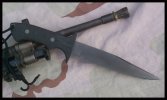Will, you are quite correct that even at the same hardness, there will be differences in strength among various alloys. However, I have not found these changes to be nearly as significant as even a very small change in RC. I have seen even extreme alloys (CPM-15V) fail to have the ability to compensate for a small RC drop and thus be outlasted edge wise by much simpler alloys (ATS-34) that were harder. I have also seen many of the cheaper blades fare exactly the same in regards to what angle will be functional for me in regards to limbing. Even though the alloys are all over the place, the hardness is usually the same, and time after time damage keeps setting in at a very similar range. Now for those blades, when you push up the RC (~10 points), and still keep the steels simple, you note a significant change in how the edge behaves. Thus hardness dominates to a huge extent over a lot of types of work. I have discussed this in detail with many other people who have looked at it detail. For example testing of simple alloys like W1 at 64-66 RC against high alloy stainless blades at 58-60 RC by Alvin Johnston (and confirmed by mps), as well as countless testing on RC and alloy effect by Phil Wilson.
I want to clarify though, I am not stating that it is all just hardness, nothing is ever this simple. For some types of cutting, wear resistance is very critical. For example when I looked at 52100 and D2 blades by Ray Kirk (same RC), the D2 one outlasted the 52100 knife over the long term, but I was cutting very abrasive material (used mats), and not only that, but I had to do very long term cutting, and many light touchups, to get past the point at which the edge holding wasn't just hardness dominated, because up to that point the edge holding was exactly the same. It would be interesting to look at something of the opposite of what I saw with those blades, like D2 at 58 RC vs 52100 at 60 RC to see when D2 would take over, which would be different for different materials being cut. Something I intend to play around with, just out of curiosity. In reality, you would just run D2 at 62 RC and thus swamp out 52100 in all aspects of edge holding, except fracture limited work.
52100 rises above 5160 in regards to wear resistance, but is not as high in regards to repeated high loads, or straight out impacts, neither resist corrosion very well. I have seen much more corrosion on 5160, but in more extreme cases than I have used 52100. The toughness of 52100 is usually not going to be the limiting factor for edge failure for most cutting work, as evidenced by Ray's blade, only being impacted by chopping through a concrete block, no gross fractures were evident. It would have been interesting to see if the greater toughness of some of the other steels would lead to less damage in such extreme uses as there was some fracturing of the very edge. Or look at the same blade at a higher RC in 52100 and see if the greater impaction resistance was functional, or would greater fracture simply take place. In actual functional use, the most I ever did to the edge on the knife was a barely visible ripple when I got sloppy doing some limbing, and the edge was very acute, ~10 per side if I recall correctly. Where I would want 5160 over 52100 was on a large blade which need to absorb high lateral loads and flexes on a regular basis, sword on sword contacts and the like.
In regards to 5160 over 1084, yes I would expect it to allow a slightly better blade for the above reasons. However I would not expect the changes to be sweeping. One of the critical factors that constrains blade performance is that while cutting is linear in angle (first order), strength is quadratic. This means that the effect of an increase in strenth is vastly undercut. For example, a blade which needs to be able to cut 40% better, needs to be fully twice as strong. Or for example, a 20% increase in strength, only leads to a 10% increase in possible cutting performance. I am just talking about straight push cuts, slices are a little more complicated, but the same principle holds. This is also a great benefit for low grade steels as the opposite holds. So a steel which is outperformed 2:1 in strength, only need have a 40% margin in cutting performance.
And again, as noted in the above, we are glossing over one of the more important aspects which is how you get maximum performance, and this isn't by any means trivial. Someone who is very experienced with 1084 will make a much better blade than he will out of 3V. You could in fact argue that he would be better off sticking with 1084 and keep advancing his blades by refining the geometry, technique and heat treatment rather than hopping from one steel to the next and restarting the process every few months as a new steel comes out.
-Cliff


